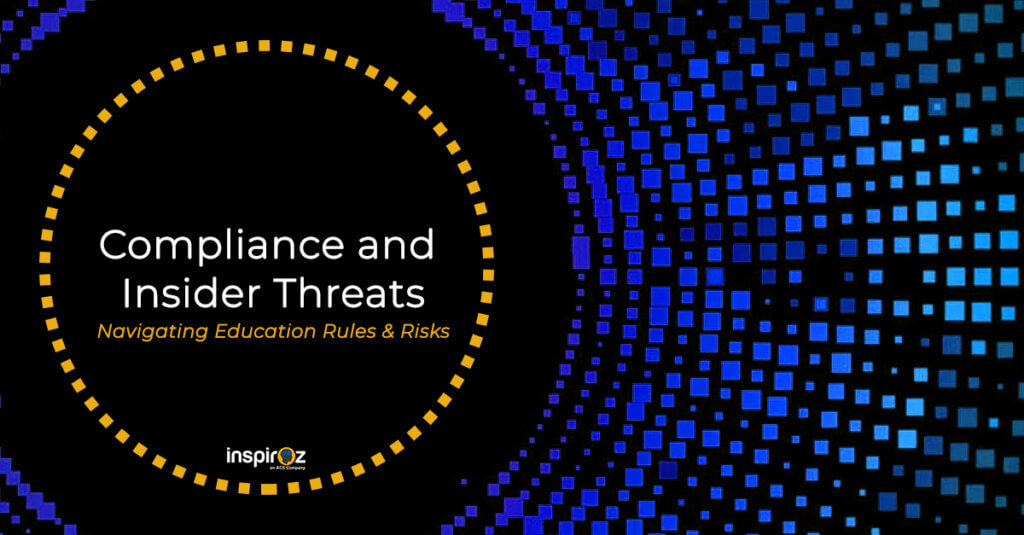U.S. educational institutions are dealing with a major challenge: how to manage a complicated web of regulations while also guarding against internal dangers.
These dangers include the possibility of financial wrongdoing and data breaches.
The rules governing U.S. educational institutions, the significance of compliance, and the methods employed to guard against insider threats will all be covered in this article.
We will organize this material in an understandable way, present it in a clear and concise manner, and back up our arguments with data.
Our aim is to bring these important topics to light.
The Regulatory Terrain
U.S. educational institutions are caught in a complex web of federal and state laws that have been carefully established to protect the rights of employees, students, and private data.
A thorough understanding of these rules is a requirement for maintaining compliance and strengthening the learning environment.
Federal Mandates:
- The Family Educational Rights and Privacy Act (FERPA):
FERPA builds a barrier of privacy around students, requiring the meticulous treatment of academic records and guaranteeing students their legal entitlements in this regard. Compliance is the defender of the confidentiality of student information.
- Impact of Data Breaches:
As per the Identity Theft Resource Center, educational institutions accounted for a substantial 11.4% of reported data breaches in the year 2020.
The Health Insurance Portability and Accountability Act (HIPAA):
Because of HIPAA’s strict rules safeguarding the security and confidentiality of medical records, it weighs large for educational institutions providing healthcare services.
Incidents in Healthcare Data:
The Protenus Breach Barometer report laid bare the unsettling fact that the educational sector bore the brunt of 43 healthcare data breaches in 2020, underscoring the indispensability of HIPAA compliance.
Title IX:
Title IX, a sentinel against gender discrimination in programs and activities funded by the federal government, plays a pivotal role in nurturing safe and all-embracing learning environments.
State-Level Regulations:
In addition to federal laws, individual states may pass their own unique rules pertaining to education, data protection, and other issues. The complex variety of state-level regulations makes compliance more difficult for educational institutions that operate in multiple states.
Multiple Requirements:
The Data Quality Campaign performed a thorough analysis that revealed the startling fact that different data protection rules exist in different U.S. states, turning compliance into an elaborate ballet for educational institutions crossing these lines.
The Need for Compliance :
Compliance with these rules is more than just a legal requirement; it is an essential part of ensuring the welfare of students, staff, and the overall integrity of the educational ecosystem.
Here, we outline the pressing reasons supporting the critical importance of compliance:
Safeguarding Student Rights:
The regulations known as FERPA and Title IX serve as unbreakable walls that protect students’ rights and ensure that their academic careers are free from discrimination and invasion of privacy.
Privacy Apprehensions:
According to a Future of Privacy Forum-commissioned survey, 87% of parents are concerned about their children’s internet privacy, underscoring the necessity of FERPA compliance.
Ensuring Financial Reliability:
Adherence to financial regulations acts as an alert against money theft and misuse, preventing resources from being misallocated away from their intended educational goals.
Financial Repercussions:
According to an in-depth study by the Association of Certified Fraud Examiners, financial fraud costs educational institutions 5% of their annual revenue, which is a staggering amount.
Improved Campus Vigilance:
The Clery Act’s regulations impose reporting requirements that enable educational institutions to find and fix security flaws, making academic institutions safer for all parties involved.
Incident Tally:
The U.S. Department of Education reports that in 2019, there were a startling 28,722 documented criminal events on American college campuses, highlighting the seriousness of adherence to the Clery Act.
Insider Threats in Education :
Although compliance is still a stronghold, it is inadequate on its own and offers no protection against insider threats that can come from employees, contractors, academics, or students, creating a genuine risk vortex. These dangers take on a variety of forms:
The Data Exigency:
Insiders with access to confidential information may, knowingly or unknowingly, trigger data leaks or theft, casting an ominous shadow over the confidentiality of student and staff data.
The prevalence of the insider threat:
According to the Verizon Data Breach Investigations Report, 34% of data breaches in 2020 had internal actors as the primary suspects.
Financial Swindle:
Personnel in key financial positions may be persuaded to engage in theft and other fraudulent activities, taking valuable funds away from the necessity of education.
Financial Fraud Mysteries:
The 2020 ACFE Report to the Nations on Occupational Fraud and Abuse revealed that educational institutions suffered a median loss of $100,000 per fraud case.
Problems with cybersecurity:
Insiders could deploy sneaky malware, plan elaborate phishing schemes, or undermine network defenses, endangering the security of vital information and operational stability.
Insider Cyber Crime: An exhaustive study conducted by IBM in conjunction with the Ponemon Institute pegged the average cost of insider-related cybersecurity incidents in 2020 at a staggering $11.45 million.
Managing Insider Threats:
The effective management of insider threats within the boundaries of educational institutions necessitates a complex strategy that works in parallel with compliance initiatives.
Here, we propose a collection of tactics designed to lessen the constant threat given by insider threats:
Comprehensive education:
Engage in the ongoing education of staff, students, and contractors, spreading awareness of the importance of compliance and the wide-ranging effects of insider threats.
Best practices for data protection, data custodianship, and the ethical framework that supports ethical behavior should all be covered in the curriculum.
- Training Impacts: A survey conducted by Security Magazine illuminated a salient truth: organizations that judiciously impart recurrent cybersecurity training to their workforce revel in a 72% reduction in the risk of data breaches.
- Restrictive Access Protocols: Create a strict access governance system that limits who has access to the sacred store of sensitive data. It is necessary that people only receive access based on their functional requirements.
- Access Prowess: According to the Identity Defined Security Alliance, 79% of businesses consider access control to be the cornerstone of the most effective defenses against the dangers of insider attacks.
Vigilant Surveillance and Audit:
Constantly examine and audit network activity, data entry, and financial transactions. Use this alertness to uncover any suspect activities. The surveillance against the spread of insider threats is early identification.
Detection Chronology:
The harsh truth that an insider threat requires an average of 280 days to uncover and contain was made clear by the Verizon Data Breach Investigations Report of 2021.
Prompt Reporting Mechanisms:
Establish clear and anonymous channels for reporting alleged insider threats or violations of legal requirements. Encourage a culture of reporting free from the fear of punishment.
Impacts of reporting:
The Cybersecurity and Infrastructure Security Agency’s (CISA) 2020 report highlighted the increased effectiveness of insider threat programs with well-established reporting channels.
Regular Risk Assessments:
To identify weaknesses within the scope of compliance and security, conduct periodic risk assessments. Utilize the learned insights to set priorities and implement improvements.
Risk Assessment’s Traction:
A study conducted by the Institute of Internal Auditors exposed the unmistakable truth that businesses with frequent risk assessments had fewer incidences of fraud.
Data Ciphering and Contingency:
Encrypt sensitive data to create a barrier against unauthorized access. Backup data frequently and simultaneously to protect it in the event of a breach.
Incident Response Protocols:
Create a comprehensive plan for handling incidents that includes communication gimmicks, legal options, and post-incident recovery procedures. Such a strategy is a sign of firm resolve in the face of insider threats.
Expertise in Incident Response:
The 2020 SANS Incident Response Survey highlighted the benefits of firms with incident response plans, emphasizing their capacity to identify and neutralize insider threats 62% faster than their unprepared competitors.
Behavioral Analytics:
Utilize the effectiveness of tools for behavioral analytics to highlight departures from typical behavioral patterns. Such anomalies frequently signal an approaching risk of insider threats.
Behavioral Analytics’ Merits:
Organizations implementing behavioral analytics to detect insider threats can decrease detection timeframes by 50%, according to a study report written by Gartner.
Conclusion:
Compliance in U.S. educational institutions is crucial for protecting student rights, fiscal integrity, and campus security.
However, it can also be a hindrance to insider threats. To mitigate these risks, institutions should implement comprehensive training, strict access governance, and robust reporting mechanisms.
This balance between compliance and security is a moral and ethical imperative that protects all stakeholders in the educational system.







